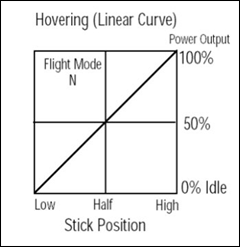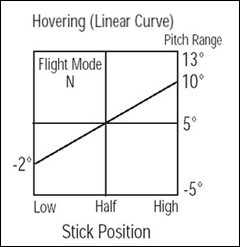Difference between revisions of "T-Rex 250 Setup"
| Line 6: | Line 6: | ||
== Radio == | == Radio == | ||
=== Pitch/Throttle curves / Dual Rates === | |||
A good radio normally has a dual-rate switch on to of the radio for Normal Mode (hovering), Stunt Mode #1 (3D), and Stunt Mode #2 (more power 3D). Stunt mode is also referred to as IdleUp 1 and IdleUp 2. Another mode is Throttle Hold for auto-rotation on engine failure, a second switch is normally used for this. | A good radio normally has a dual-rate switch on to of the radio for Normal Mode (hovering), Stunt Mode #1 (3D), and Stunt Mode #2 (more power 3D). Stunt mode is also referred to as IdleUp 1 and IdleUp 2. Another mode is Throttle Hold for auto-rotation on engine failure, a second switch is normally used for this. | ||
| Line 18: | Line 19: | ||
[[Image:helicopter_stuntmode_throttle.png|300px]] | [[Image:helicopter_stuntmode_throttle.png|300px]] | ||
[[Image:helicopter_stuntmode_pitch.png|300px]] | [[Image:helicopter_stuntmode_pitch.png|300px]] | ||
==== Collective Cyclive Pitch Mixing ==== | |||
CCPM Setup: | |||
* 120° degrees apart | |||
* 40-60% | |||
Also known as CCPM. This controls the pitch of the rotor and makes the heli lift. There are two types of CCPM, mechanical crankbell and electronic mixing. The latter one is used on most newer helicopters but requires some initial radio setup. | |||
== Gyro == | == Gyro == | ||
Revision as of 19:37, 28 April 2009
This shows the setup of my T-Rex 250 and the experience I've had learning and experimenting with the build. Please visit RC Heli Wiki for an excellent resource regarding helicopter terms and concepts.
Rotor
Tail
Radio
Pitch/Throttle curves / Dual Rates
A good radio normally has a dual-rate switch on to of the radio for Normal Mode (hovering), Stunt Mode #1 (3D), and Stunt Mode #2 (more power 3D). Stunt mode is also referred to as IdleUp 1 and IdleUp 2. Another mode is Throttle Hold for auto-rotation on engine failure, a second switch is normally used for this.
File:Helicopter dualrate switch.jpg
Normal Mode is used during spin-up and hovering. With the stick down the engine will be off and with 70% up the helicopter should be hovering. These parameters are mainly set-up on the radio by altering the engine throttle and rotor pitch curve.
With Stunt Mode turned on the hovering mode is turned into a flexible mode where the helicopter can be flown up-side-down. Essentially the Normal Mode above 50% is mirrored to the 0-49% section of the stick, but with a negative rotor pitch instead. Look at the picture below to understand the difference between Normal and Stunt.

 File:Helicopter stuntmode throttle.png
File:Helicopter stuntmode pitch.png
File:Helicopter stuntmode throttle.png
File:Helicopter stuntmode pitch.png
Collective Cyclive Pitch Mixing
CCPM Setup:
- 120° degrees apart
- 40-60%
Also known as CCPM. This controls the pitch of the rotor and makes the heli lift. There are two types of CCPM, mechanical crankbell and electronic mixing. The latter one is used on most newer helicopters but requires some initial radio setup.
Gyro
GP750 settings:
- Pulse frame: 1520us
- Servo type: DS (Digital Servo)
- Direction: Rev (mounted up-side-down)
- Servo travel: Limit set with no binding
- Heli type: Small heli
- Delay: 0 delay
ESC
The default configuration:
- Soft start
- 6v BEC to receiver/servos
Although the ESC is pre-programmed from factory, re-program it to make sure the throttle range matches the transmitter stick range. It also fixes any issues that might be introduced during manufacturing or storage.